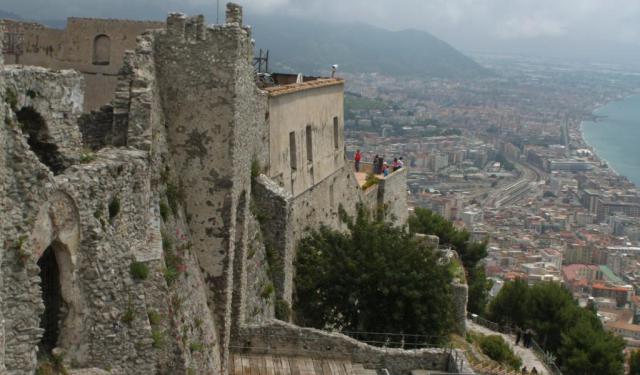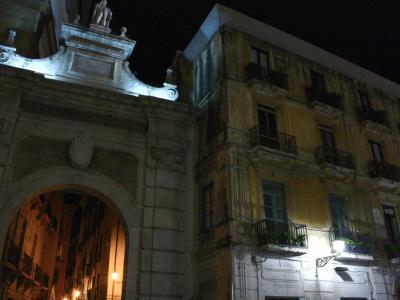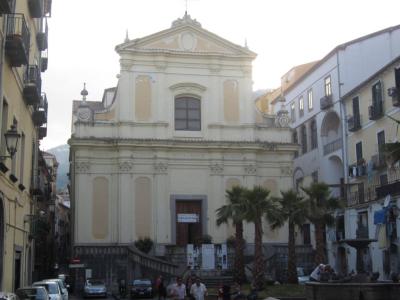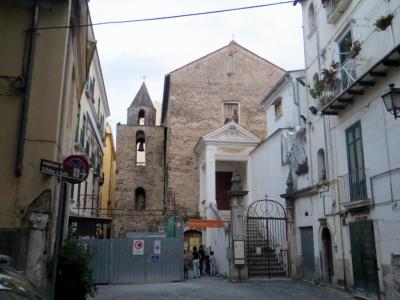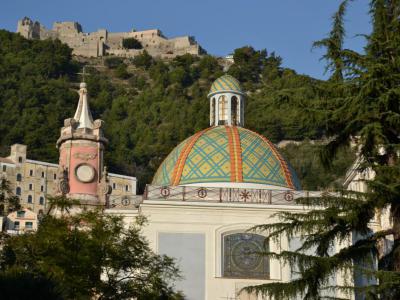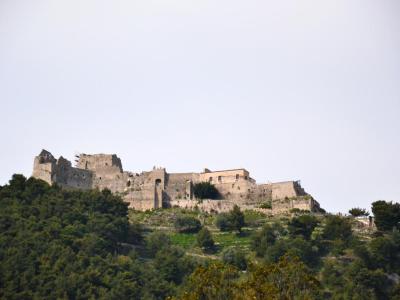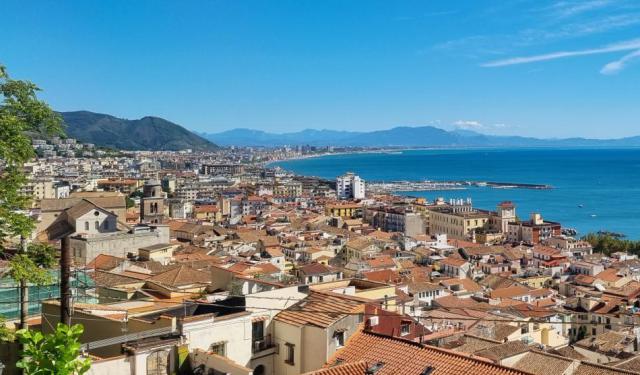Salerno Medieval Architecture Walking Tour (Self Guided), Salerno
Salerno's medieval architecture is a captivating tapestry woven with the threads of history, culture, and craftsmanship. Our journey through its facets starts by the sea, at the ancient New Gate (Porta Nova) that once served as a crucial entry point to the city, welcoming travelers and protecting residents within its sturdy walls.
Our next stop is the picturesque Medieval Aqueduct (Acquedotto Medievale di Salerno), standing as a marvel of engineering prowess, whose pointed arches today intersect with early 20th-century apartment buildings.
Another point of interest is the imposing 11th-century Norman cathedral; its magnificent presence casts a historic aura over the surrounding landscape.
The Monumental Complex of Santa Sofia (Complesso Monumentale di Santa Sofia) is a cultural treasure trove, housing a wealth of historical artifacts that offer a glimpse into Salerno's illustrious past.
The 13th-century Fruscione Palace, in turn, exudes elegance and aristocratic charm – a testament to the wealth and influence of Salerno's elite during the medieval period.
The Monumental Complex of San Pietro a Corte stands as a silent sentinel, guarding the city's secrets and bearing witness to its tumultuous history.
The Church of the Most Holy Annunciation (Chiesa della Santissima Annunziata) is a sanctuary of peace and tranquility, its sacred halls echoing with centuries of prayer and devotion.
Having made our way upwards through a labyrinth of tunneled passageways, we will finally arrive at the ruins of an ancient castle perched on top of a mountain offering sweeping views of the Amalfi Coast. The Arechi Castle looms majestically over the city as a former symbol of power and authority – a reminder of Salerno's strategic importance in the medieval era.
Each of these buildings, either crumbling or well-preserved, is a piece of poetry set in stone. Their collective story is equally interesting for a history enthusiast or architecture aficionado. So, come, explore, and discover the timeless magic of Salerno. Its medieval treasures are sure to leave you with a lasting impression!
Our next stop is the picturesque Medieval Aqueduct (Acquedotto Medievale di Salerno), standing as a marvel of engineering prowess, whose pointed arches today intersect with early 20th-century apartment buildings.
Another point of interest is the imposing 11th-century Norman cathedral; its magnificent presence casts a historic aura over the surrounding landscape.
The Monumental Complex of Santa Sofia (Complesso Monumentale di Santa Sofia) is a cultural treasure trove, housing a wealth of historical artifacts that offer a glimpse into Salerno's illustrious past.
The 13th-century Fruscione Palace, in turn, exudes elegance and aristocratic charm – a testament to the wealth and influence of Salerno's elite during the medieval period.
The Monumental Complex of San Pietro a Corte stands as a silent sentinel, guarding the city's secrets and bearing witness to its tumultuous history.
The Church of the Most Holy Annunciation (Chiesa della Santissima Annunziata) is a sanctuary of peace and tranquility, its sacred halls echoing with centuries of prayer and devotion.
Having made our way upwards through a labyrinth of tunneled passageways, we will finally arrive at the ruins of an ancient castle perched on top of a mountain offering sweeping views of the Amalfi Coast. The Arechi Castle looms majestically over the city as a former symbol of power and authority – a reminder of Salerno's strategic importance in the medieval era.
Each of these buildings, either crumbling or well-preserved, is a piece of poetry set in stone. Their collective story is equally interesting for a history enthusiast or architecture aficionado. So, come, explore, and discover the timeless magic of Salerno. Its medieval treasures are sure to leave you with a lasting impression!
How it works: Download the app "GPSmyCity: Walks in 1K+ Cities" from Apple App Store or Google Play Store to your mobile phone or tablet. The app turns your mobile device into a personal tour guide and its built-in GPS navigation functions guide you from one tour stop to next. The app works offline, so no data plan is needed when traveling abroad.
Salerno Medieval Architecture Walking Tour Map
Guide Name: Salerno Medieval Architecture Walking Tour
Guide Location: Italy » Salerno (See other walking tours in Salerno)
Guide Type: Self-guided Walking Tour (Sightseeing)
# of Attractions: 8
Tour Duration: 2 Hour(s)
Travel Distance: 2.8 Km or 1.7 Miles
Author: DanaOffice
Sight(s) Featured in This Guide:
Guide Location: Italy » Salerno (See other walking tours in Salerno)
Guide Type: Self-guided Walking Tour (Sightseeing)
# of Attractions: 8
Tour Duration: 2 Hour(s)
Travel Distance: 2.8 Km or 1.7 Miles
Author: DanaOffice
Sight(s) Featured in This Guide:
- Porta Nova (New Gate)
- Acquedotto Medievale di Salerno (Medieval Aqueduct of Salerno)
- Duomo di Salerno (Cathedral of Salerno)
- Complesso Monumentale di Santa Sofia (Monumental Complex of Santa Sofia)
- Palazzo Fruscione (Fruscione Palace)
- Complesso Monumentale di San Pietro a Corte (Monumental Complex of San Pietro a Corte)
- Chiesa della Santissima Annunziata (Church of the Most Holy Annunciation)
- Castello di Arechi (Castle of Arechi)
1) Porta Nova (New Gate)
The New Gate emerged in 1754 under the skilled craftsmanship of master Ragozzino. This imposing gate replaced the former Porta Elina, exhibiting an elegant eighteenth-century style adorned with marble and crowned by the magnificent statue of San Matteo. The sculptor Francesco Pagano contributed to the gate's artistic finesse, completing the statue in 1756.
The square opposite the New Gate, historically significant, hosted the renowned San Matteo Fair during the Middle Ages and modern era. This fair was a prestigious gathering, drawing merchants from across Southern Italy to showcase and trade a diverse array of goods. The square, once a bustling marketplace, also served as the site for capital sentences in times past.
On the right side of Portanova Square, a vivid reminder of the area's historical gravity persists in the form of a late seventeenth-century wall painting known as the Madonna delle Grazie. This votive aedicule once provided a poignant backdrop as the condemned offered their final prayers. Across from this memorial stands the church of San Pietro in Vinculis, historically affiliated with the brotherhood of the same name, offering solace and aid to prisoners.
The square opposite the New Gate, historically significant, hosted the renowned San Matteo Fair during the Middle Ages and modern era. This fair was a prestigious gathering, drawing merchants from across Southern Italy to showcase and trade a diverse array of goods. The square, once a bustling marketplace, also served as the site for capital sentences in times past.
On the right side of Portanova Square, a vivid reminder of the area's historical gravity persists in the form of a late seventeenth-century wall painting known as the Madonna delle Grazie. This votive aedicule once provided a poignant backdrop as the condemned offered their final prayers. Across from this memorial stands the church of San Pietro in Vinculis, historically affiliated with the brotherhood of the same name, offering solace and aid to prisoners.
2) Acquedotto Medievale di Salerno (Medieval Aqueduct of Salerno)
The Medieval Aqueduct of Salerno, often referred to as the Devil's Bridges, stands as an iconic symbol and a marvel of medieval engineering. Constructed in the 10th century by Benedictine monks, the Medieval Aqueduct traverses Via Arce, representing a conduit that transported water from the northern hills to the Monastery of San Benedetto. Folklore intertwines with the aqueduct's history, as it is fondly known as "the Devil's Bridges."
The aqueduct, colloquially known as the "Devil's Bridge", earned its mysterious reputation from a captivating legend that unfolded in the 12th century. According to local lore, the renowned Salerno magician Pietro Barliario, aided by supernatural forces, constructed this marvel overnight. Fueled by popular superstition, tales circulated that venturing beneath the arches between dusk and dawn could lead to encounters with devils or malevolent spirits.
The legend finds its roots in the unique topography of the aqueduct's location. Until the early 20th century, the area remained inaccessible, with the Rafastia stream flowing beneath the road surface and devoid of houses, nestled close to the towering city walls. The pointed arch, an architectural innovation of the time, likely added an element of awe and fear, contributing to the mystical aura surrounding the aqueduct.
Another captivating tale weaves through the arches, claiming that the four founders of the Salerno Medical School serendipitously met beneath the aqueduct on a stormy night. Adela, representing the Arab influence, Ponto from Greece, Elino, a Jewish figure, and the Latin Salerno, symbolizing the local essence, allegedly converged in a moment that echoed Salerno's role as a bustling crossroads of diverse peoples, religions, and cultures during that era.
The aqueduct, colloquially known as the "Devil's Bridge", earned its mysterious reputation from a captivating legend that unfolded in the 12th century. According to local lore, the renowned Salerno magician Pietro Barliario, aided by supernatural forces, constructed this marvel overnight. Fueled by popular superstition, tales circulated that venturing beneath the arches between dusk and dawn could lead to encounters with devils or malevolent spirits.
The legend finds its roots in the unique topography of the aqueduct's location. Until the early 20th century, the area remained inaccessible, with the Rafastia stream flowing beneath the road surface and devoid of houses, nestled close to the towering city walls. The pointed arch, an architectural innovation of the time, likely added an element of awe and fear, contributing to the mystical aura surrounding the aqueduct.
Another captivating tale weaves through the arches, claiming that the four founders of the Salerno Medical School serendipitously met beneath the aqueduct on a stormy night. Adela, representing the Arab influence, Ponto from Greece, Elino, a Jewish figure, and the Latin Salerno, symbolizing the local essence, allegedly converged in a moment that echoed Salerno's role as a bustling crossroads of diverse peoples, religions, and cultures during that era.
3) Duomo di Salerno (Cathedral of Salerno) (must see)
The Cathedral of San Matteo, commonly known as Salerno Cathedral, stands as a venerable testament to history, with its roots tracing back to the auspicious founding by Robert Guiscard and consecration by Pope Gregory VII. Officially inaugurated in March 1084, the cathedral underwent a transformative chapter following the earthquake of June 5, 1688, which led to its complete reconstruction.
As one approaches the cathedral, the main entrance reveals modifications, and its courtyard is gracefully encircled by a covered passage supported by twenty-eight simple columns adorned with arches. Along the walls, a series of Roman tombs add an evocative touch to the surroundings. The southern side boasts the 12th-century bell tower, an architectural relic that stands in silent homage to the passage of time.
Salerno Cathedral unfolds its architectural narrative through a plan characterized by a longitudinal body comprising three naves, complemented by a horizontal transept with three apses and a quadriportico. The crypt, a distinctive element, assumes the form of a hall divided by columns, with apses mirroring those of the upper transept. Notably, the crypt serves as the resting place for the mortal remains of Saint Matthew. Legend holds that Gisulfo I transported the relics to Salerno in the 10th century. In 1081, upon the completion of the new cathedral dedicated to the evangelist, the remains found their eternal abode in the crypt, meticulously safeguarded.
The sculptural tapestry of Salerno Cathedral resonates with a captivating presence of animals. Beginning with the entrance, symbols of ecclesiastical power and charity manifest in the depiction of a lion and a lioness breastfeeding her calf. The architrave, adorned with a vine trellis, intertwines with dates pecked by birds, metaphorically alluding to the spiritual nourishment of the soul. At the extremes, a monkey and a lion symbolize heresy and the truth of the church, respectively. The cathedral's interiors are further embellished with decorative elements, featuring medieval heritage animals such as lions, horses, and centaurs.
As one approaches the cathedral, the main entrance reveals modifications, and its courtyard is gracefully encircled by a covered passage supported by twenty-eight simple columns adorned with arches. Along the walls, a series of Roman tombs add an evocative touch to the surroundings. The southern side boasts the 12th-century bell tower, an architectural relic that stands in silent homage to the passage of time.
Salerno Cathedral unfolds its architectural narrative through a plan characterized by a longitudinal body comprising three naves, complemented by a horizontal transept with three apses and a quadriportico. The crypt, a distinctive element, assumes the form of a hall divided by columns, with apses mirroring those of the upper transept. Notably, the crypt serves as the resting place for the mortal remains of Saint Matthew. Legend holds that Gisulfo I transported the relics to Salerno in the 10th century. In 1081, upon the completion of the new cathedral dedicated to the evangelist, the remains found their eternal abode in the crypt, meticulously safeguarded.
The sculptural tapestry of Salerno Cathedral resonates with a captivating presence of animals. Beginning with the entrance, symbols of ecclesiastical power and charity manifest in the depiction of a lion and a lioness breastfeeding her calf. The architrave, adorned with a vine trellis, intertwines with dates pecked by birds, metaphorically alluding to the spiritual nourishment of the soul. At the extremes, a monkey and a lion symbolize heresy and the truth of the church, respectively. The cathedral's interiors are further embellished with decorative elements, featuring medieval heritage animals such as lions, horses, and centaurs.
4) Complesso Monumentale di Santa Sofia (Monumental Complex of Santa Sofia)
The Monumental Complex of Santa Sofia, comprising the Church of Addolorata and the Monastery of Santa Sofia, stands as a testament to Salerno's rich historical tapestry, with roots dating back to the 9th century. The monastery, harking back to Lombard origins, carries a name inspired by the Church of Benevento and the imperial church of Constantinople, both dedicated to the venerated Saint of Knowledge.
Throughout its history, the complex underwent various transformations, and in the 16th century, it witnessed the arrival of the Jesuits in Salerno. This marked a significant chapter as they settled in the monastery and contributed to the construction of the present-day church. The architectural splendor of the staircase leading to the church reflects the dramatic intentions characteristic of the Counter-Reformation era, showcasing the Jesuits' commitment to sacred representation.
The square encompassing the complex exudes a picturesque charm, situated in a location with historical significance, often identified as the potential site of the Forum in Roman times. Some even consider it the starting point of the road leading to Nocera. Today, the church serves as a venue for cultural events and exhibitions, preserving its historical ambiance. Inside, visitors are treated to a visual feast with wall paintings dating back to the 16th and 17th centuries.
Throughout its history, the complex underwent various transformations, and in the 16th century, it witnessed the arrival of the Jesuits in Salerno. This marked a significant chapter as they settled in the monastery and contributed to the construction of the present-day church. The architectural splendor of the staircase leading to the church reflects the dramatic intentions characteristic of the Counter-Reformation era, showcasing the Jesuits' commitment to sacred representation.
The square encompassing the complex exudes a picturesque charm, situated in a location with historical significance, often identified as the potential site of the Forum in Roman times. Some even consider it the starting point of the road leading to Nocera. Today, the church serves as a venue for cultural events and exhibitions, preserving its historical ambiance. Inside, visitors are treated to a visual feast with wall paintings dating back to the 16th and 17th centuries.
5) Palazzo Fruscione (Fruscione Palace)
The construction of Fruscione Palace, initiated in the 13th century, holds a historical tapestry intertwined with the city's rich past. Partially resting on the remains of an imperial-era thermal complex, the palace shares its vicinity with the ancient Arechian court.
The palace encapsulates remnants of a Norman structure spanning at least two floors, with varying building levels. The 13th century witnessed renovation works and street reorganization, evidenced by the three portals on Vicolo dei Barbuti. The rooms on Vicolo Adelberga took shape towards the late 13th century, while the second floor emerged from a comprehensive intervention completed in the early 14th century.
In the 17th century, the ground floor underwent transformation into stables, resulting in the loss of the ancient peacock-tail staircase leading to the upper levels. In the 19th century, efforts were made to restore the grandeur of these spaces, adorned with embellishments such as two marble jambs featuring intricate vegetal themes.
Palazzo Fruscione proudly exhibits three orders adorned with noteworthy architectural elements. The eastern façade showcases three portals on the ground floor crowned by round arches with gray and yellow tuff inlays. The first floor boasts five sculpted mullioned windows, one adorned with a red-painted decoration depicting intertwined rings. The second floor features a series of intertwined multi-lancet windows characterized by pointed arches and supported by small columns.
The palace encapsulates remnants of a Norman structure spanning at least two floors, with varying building levels. The 13th century witnessed renovation works and street reorganization, evidenced by the three portals on Vicolo dei Barbuti. The rooms on Vicolo Adelberga took shape towards the late 13th century, while the second floor emerged from a comprehensive intervention completed in the early 14th century.
In the 17th century, the ground floor underwent transformation into stables, resulting in the loss of the ancient peacock-tail staircase leading to the upper levels. In the 19th century, efforts were made to restore the grandeur of these spaces, adorned with embellishments such as two marble jambs featuring intricate vegetal themes.
Palazzo Fruscione proudly exhibits three orders adorned with noteworthy architectural elements. The eastern façade showcases three portals on the ground floor crowned by round arches with gray and yellow tuff inlays. The first floor boasts five sculpted mullioned windows, one adorned with a red-painted decoration depicting intertwined rings. The second floor features a series of intertwined multi-lancet windows characterized by pointed arches and supported by small columns.
6) Complesso Monumentale di San Pietro a Corte (Monumental Complex of San Pietro a Corte)
The Monumental Complex of San Pietro a Corte represents a pinnacle of Medieval architecture and the exclusive example of a Palace building complex from the Longobard era in Europe. This monumental site served as the prestigious seat of the Longobard Court in Campania, a symbol of political and strategic importance.
Constructed by Duke Arechi II of Benevento in 774, following the defeat of the Northern Longobards by Charles Magnus, San Pietro a Corte became the new residence for the duke, who had been granted the title of Princeps gentis langobardorum. The architectural remains include the upper room's pilasters, which stand on the frigidarium of a spa complex dating back to the imperial age (late 1st – early 2nd century AD). This structure, initially part of a spa, was later repurposed as a Christian burial ground, where notable personalities of the time, referred to as vir spectabilis, found their resting place.
The upper level of the complex likely housed the official room, possibly accompanied by a Palatine chapel. In 1567, the commendatory abbot Decio Caracciolo introduced modifications, including the current grand staircase visible from Largo Antica Corte. In the subsequent centuries, between the 13th and 16th centuries, a chapel devoted to the Virgin Mary was added.
Presently undergoing restoration, the complex aspires to become a museum showcasing the rich Longobard civilization of Southern Italy.
Constructed by Duke Arechi II of Benevento in 774, following the defeat of the Northern Longobards by Charles Magnus, San Pietro a Corte became the new residence for the duke, who had been granted the title of Princeps gentis langobardorum. The architectural remains include the upper room's pilasters, which stand on the frigidarium of a spa complex dating back to the imperial age (late 1st – early 2nd century AD). This structure, initially part of a spa, was later repurposed as a Christian burial ground, where notable personalities of the time, referred to as vir spectabilis, found their resting place.
The upper level of the complex likely housed the official room, possibly accompanied by a Palatine chapel. In 1567, the commendatory abbot Decio Caracciolo introduced modifications, including the current grand staircase visible from Largo Antica Corte. In the subsequent centuries, between the 13th and 16th centuries, a chapel devoted to the Virgin Mary was added.
Presently undergoing restoration, the complex aspires to become a museum showcasing the rich Longobard civilization of Southern Italy.
7) Chiesa della Santissima Annunziata (Church of the Most Holy Annunciation)
Graced by a magnificent bell tower and crowned with a resplendent majolica dome, the Church of the Most Holy Annunciation occupies the site where the ancient Portacatena once stood-a vital city entrance. Positioned at the terminus of via Portacatena, it forms one vertex of the historical Salerno triangle, along with the Arechi Castle and Porta Nova, marking the geographical center of the city's rich heritage.
The church's origins trace back to significant donations from Queen Margherita of Durazzo in 1404 and 1412. Over its history, the church weathered various reconstructions necessitated by natural calamities. Extensively renovated in the mid-19th century, it endured a significant setback during the 1954 flood when engulfed by mud and debris. Yet, resiliently restored over three years, it emerged adorned with marble, stucco, and decorative elements in the vaults and lateral chapels.
With its longitudinal plan and a presbytery beneath a striking dome, the church exudes a pronounced eighteenth-century aesthetic. Inside, the influence of renowned Neapolitan artists is palpable. Filippo and Giovanni Ragozzino, alongside Matteo Bottigliero, crafted the splendid Baroque main altar at the terminus of the single nave, adorned with polychrome decorations. Notable features include the meticulously crafted wooden entrance door of the sacristy, fashioned in 1712 by the master shipwright Saviotto, and the neo-Gothic wooden organ from 1880, positioned on the counter-façade.
A recent addition to the church's allure is the breathtaking majolica embellishment on its dome, a testament to ongoing efforts to enhance this architectural gem.
The church's origins trace back to significant donations from Queen Margherita of Durazzo in 1404 and 1412. Over its history, the church weathered various reconstructions necessitated by natural calamities. Extensively renovated in the mid-19th century, it endured a significant setback during the 1954 flood when engulfed by mud and debris. Yet, resiliently restored over three years, it emerged adorned with marble, stucco, and decorative elements in the vaults and lateral chapels.
With its longitudinal plan and a presbytery beneath a striking dome, the church exudes a pronounced eighteenth-century aesthetic. Inside, the influence of renowned Neapolitan artists is palpable. Filippo and Giovanni Ragozzino, alongside Matteo Bottigliero, crafted the splendid Baroque main altar at the terminus of the single nave, adorned with polychrome decorations. Notable features include the meticulously crafted wooden entrance door of the sacristy, fashioned in 1712 by the master shipwright Saviotto, and the neo-Gothic wooden organ from 1880, positioned on the counter-façade.
A recent addition to the church's allure is the breathtaking majolica embellishment on its dome, a testament to ongoing efforts to enhance this architectural gem.
8) Castello di Arechi (Castle of Arechi) (must see)
Perched atop Mount Bonadies, approximately 300 meters above sea level, the imposing Arechi Castle commands a commanding presence over the city of Salerno and its Gulf. With its origins tracing back to the Gothic-Byzantine period, the castle underwent significant expansion and fortification during the tenure of Lombard Prince Arechi II.
Constructed with blocks of local dark stone, the castle's architecture is a testament to its storied past. The central section, flanked by towers and encircled by a crenelated wall with drawbridges, showcases the medieval defensive ingenuity of its Lombard builders. Noteworthy among its features is the Bastille, a watchtower positioned to the northwest, exemplifying the robustness of the castle's defensive system, which, historically, was never conquered by chance.
Surrounded by a verdant park, the Arechi Castle offers visitors enchanting nature trails amid the Mediterranean scrub. Within the castle complex, visitors can explore the Archaeological Museum, home to a diverse array of artifacts such as ceramics, glass fragments, furnishings, and coins. Additionally, the Multimedia Museum provides an immersive experience, offering a video itinerary that delves into the castle's rich history through ancient finds, photographs, historical films, and insights into medieval customs.
Accessing Arechi Castle involves ascending steps and following a scenic path through the trees. The journey is rewarded with breathtaking panoramic views of Salerno from the castle's vantage point. Alternatively, the Castle can be reached by bus or taxi.
Constructed with blocks of local dark stone, the castle's architecture is a testament to its storied past. The central section, flanked by towers and encircled by a crenelated wall with drawbridges, showcases the medieval defensive ingenuity of its Lombard builders. Noteworthy among its features is the Bastille, a watchtower positioned to the northwest, exemplifying the robustness of the castle's defensive system, which, historically, was never conquered by chance.
Surrounded by a verdant park, the Arechi Castle offers visitors enchanting nature trails amid the Mediterranean scrub. Within the castle complex, visitors can explore the Archaeological Museum, home to a diverse array of artifacts such as ceramics, glass fragments, furnishings, and coins. Additionally, the Multimedia Museum provides an immersive experience, offering a video itinerary that delves into the castle's rich history through ancient finds, photographs, historical films, and insights into medieval customs.
Accessing Arechi Castle involves ascending steps and following a scenic path through the trees. The journey is rewarded with breathtaking panoramic views of Salerno from the castle's vantage point. Alternatively, the Castle can be reached by bus or taxi.
Walking Tours in Salerno, Italy
Create Your Own Walk in Salerno
Creating your own self-guided walk in Salerno is easy and fun. Choose the city attractions that you want to see and a walk route map will be created just for you. You can even set your hotel as the start point of the walk.
Salerno Introduction Walking Tour
A vibrant seaport on the southeastern fringe of Italy's famed Amalfi Coast – the one often viewed as an attraction for jet-setters, – Salerno stands apart from its glitzy counterparts in that it is favored by those who seek a serene yet captivating retreat.
Human settlement at Salerno dates back to pre-historic times. The city's name, believed to have originated from the Latin... view more
Tour Duration: 2 Hour(s)
Travel Distance: 3.5 Km or 2.2 Miles
Human settlement at Salerno dates back to pre-historic times. The city's name, believed to have originated from the Latin... view more
Tour Duration: 2 Hour(s)
Travel Distance: 3.5 Km or 2.2 Miles
The Most Popular Cities
/ view all
